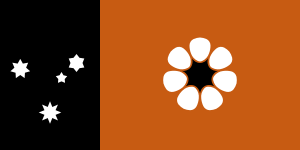Gossypium sturtianum facts for kids
Gossypium sturtianum, often called Sturt's Desert Rose, is a special native Australian plant. It is the official floral emblem of the Northern Territory, meaning it represents that part of Australia. This pretty flower was named after an explorer named Charles Sturt. He discovered the plant in 1844 near creeks close to Broken Hill, New South Wales. Sturt collected seeds from the plant and brought them back for Robert Brown, a Scottish botanist (a scientist who studies plants), to examine.
A cool, artistic drawing of the flower is even used on the Northern Territory's flag, showing how important it is to the region.
Contents
What is Sturt's Desert Rose?
Sturt's Desert Rose is a type of plant that belongs to the mallow family. This family also includes cotton plants! It grows as a small shrub, usually reaching about 1 to 2 meters (3 to 6 feet) tall. Its leaves are round or oval-shaped and have small, dark spots.
The Beautiful Flowers
The flowers of Sturt's Desert Rose are its most striking feature. They are usually purple or pink, but sometimes they can be white or pale yellow. Each flower has five petals that form a cup shape, with a dark red or purple center. These flowers don't last very long, often only a day, but new ones keep blooming, especially after rain.
Where Does Sturt's Desert Rose Grow?
This tough plant is found in dry, rocky areas across many parts of Australia. You can see it growing naturally in the Northern Territory, Queensland, New South Wales, South Australia, and Western Australia. It loves dry riverbeds, rocky hillsides, and sandy plains. It's very good at surviving in places with little water, which is why it's called a "desert rose."
Why is it Important?
Sturt's Desert Rose is important for several reasons:
- Floral Emblem: As the floral emblem of the Northern Territory, it represents the unique beauty and toughness of the region's plant life.
- Native Plant: It's a key part of Australia's native plant life, helping to keep the natural environment healthy.
- Tough Survivor: Its ability to grow in harsh, dry conditions makes it a symbol of resilience.
Life Cycle and Reproduction
Sturt's Desert Rose usually flowers during the cooler months, from late autumn through to spring. After the flowers bloom, they produce small, round seed pods. These pods contain the seeds, which are covered in a soft, cotton-like fuzz. The plant reproduces from these seeds, which can spread naturally or be planted by people.
Images for kids
See also
 In Spanish: Sturt's Desert Rose para niños
In Spanish: Sturt's Desert Rose para niños




